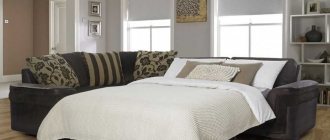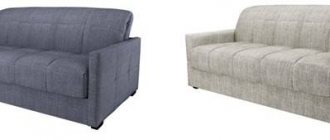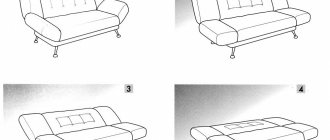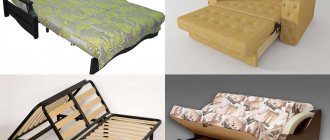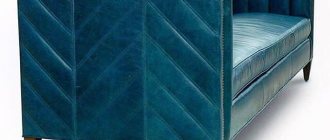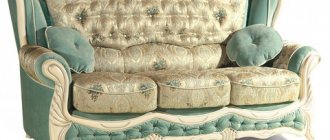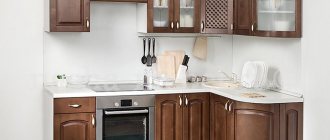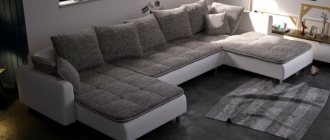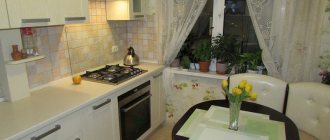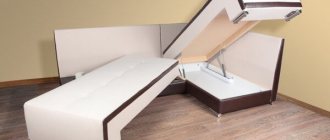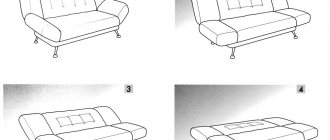New leather soft sofa for a beautiful living room
Many, having completed renovations in their apartment, purchase new upholstered furniture, if funds, of course, allow. But the choice must be right. In addition to the durability, cozy appearance, and transformation mechanism, you should pay attention to the filling and ask the seller what the “filling” of the sofa is. How comfortable you will be depends on this. Nowadays there are a lot of fillers, you need to have an idea about some of them, their quality, quality factor, how long furniture with such a filler can last.
Types of fillers for upholstered furniture
Furniture manufacturers often use polyurethane foam (PUF) as filling. Lots of box spring sofas. Buyers are sometimes confused as to which is better, a spring or polyurethane foam, and cannot make a choice.
Blue orthopedic sofa with spring block in section
Sectional view of a sofa with polyurethane foam with a list of materials and components
Spring fillers
There are several types of spring fillers - independent spring block, dependent spring block "Bonnel" and spring block "Snake". They differ depending on:
- spring diameter;
- their heights;
- the thickness of the metal rod from which the springs are made;
- number of springs per square meter.
The technology for manufacturing spring fillers is quite old, but they are still popular because they have a number of advantages:
- withstand heavy weight;
- durable to use;
- have orthopedic properties;
- good air exchange;
- sufficient elasticity and rigidity.
Spring fillers inside sofas are found both in antique furniture and in modern sofa models.
Independent spring block
It consists of separate elements representing barrel-shaped springs that do not touch each other. Each spring is placed in a separate cover made of non-woven material, which has a high level of strength. The covers are connected with elastic connections, and the entire structure is glued on both sides with non-woven fabric, which eliminates deformation.
In such structures, the load is distributed pointwise, the block does not sag, and is silent when the resting person changes position.
Independent block springs have a diameter of 5 to 6 centimeters and a density of 250 pieces per square meter. To give softness to the sofa seat, the independent spring block is covered on both sides with soft material - coconut coir or felt.
Dependent spring block "Bonnel"
In this design, high-quality steel springs are connected to each other by steel wire with knots. The entire structure is secured on both sides with a metal frame, which makes the block stable, since the displacement of the springs is eliminated. The Bonnel block is elastic and reliable, capable of withstanding significant loads. The small diameter of the springs and their high density per square meter achieve the orthopedic effect of the product.
The top of the springs is covered with additional soft fillings for the comfort of the furniture.
Spring block “Snake”
Used in the seat and back of the sofa. Galvanized metal springs are located transversely to the base. They are attached to the wooden base with clips or hinged strips. The top is covered with felt. The seat is soft with a springy effect. Such a spring block is not able to withstand heavy loads and after some time of use begins to sag. Therefore, sofas with such filling are not suitable for sleeping.
For which rooms is a sofa filled with PUU suitable?
So, before buying a sofa filled with polyurethane foam, you need to determine for which room the sofa is intended, the load on it and the degree of intensity of use. For example:
For the living room
If the house has private bedrooms, then the sofa in the living room is unlikely to be used for sleeping. If only in force majeure situations. Therefore, the rigidity of polyurethane foam for this option should be moderate.
For bedrooms
If sofas in such rooms are more appropriate than beds, then the intensity of use of such furniture increases significantly. Therefore, the rigidity, elasticity, tear resistance and inertness to other negative factors of such models should be an order of magnitude higher than that of polyurethane foam for sofas with a low degree of use.
For children
Considering that the activity of children is enormous, sofas with PU foam are not the best purchase for children's rooms. However, parents are more often guided by the financial factor - polyurethane foam is cheaper than spring blocks.
The fact that children grow quickly speaks in favor of the polymer, so over time the sofa will have to be replaced with a larger model, so the expense is justified.
The level of rigidity should be appropriately high, and it is also advisable to buy a filler option treated with a fire retardant (fire retardant).
For kitchen
If the kitchen area allows you to fit a sofa filled with polyurethane foam, you need to take care of its quality. The kitchen is a humid room with high temperatures. Polymer, as a filler, is best suited for this, since it does not react to moisture at all and does not absorb odors. But at the same time, the kitchen remains a dangerous room where fire is possible. Therefore, a special type of polyurethane foam is needed that is not capable of burning and emitting harmful gases.
Polyurethane foam
Polyurethane foam is a synthetic, highly porous foam material that is obtained by mixing several synthetic polymers.
more durable passportReceipt technology
There are two types of PPU:
- Cast polyurethane foam, which initially has a liquid state. It is poured into special molds that follow the contours and dimensions of the future sofa part. Under the influence of high pressure and significant temperature, it hardens. The resulting element is ready for use and has high dimensional accuracy. In this way, both the seat and the back or side cushions of the sofa can be made. The disadvantage of the cast type is the crust that forms on the surface as a result of sintering. Air circulation may be difficult in this case, which can lead to the formation of a “greenhouse effect.”
- Block polyurethane foam is often called a “sandwich”. This is due to the method of its production. The material comes in the form of large sheets of varying thickness and density. From these sheets, elements of the required sizes are cut and glued together. In this way, different levels of rigidity and height can be achieved. It is precisely because of the presence of several layers that the finished product resembles a sandwich.
For the manufacture of various elements of the sofa, sheets of different degrees of rigidity are used. Products made from polyurethane foam do not tolerate direct sunlight. Under their influence, they can crumble, so mattresses made of this material are additionally protected with covers made of light-proof fabric. An interesting feature of some PU foam compositions is that they have a shape memory effect. It is usually used to make pillows that remember the contours of the human body and adapt to them as much as possible. But as soon as you get up, the pillow will instantly return to its original state.
A product filled with high-quality polyurethane foam will be more affordable in cost than a “Pocket spring” block, and its properties and level of comfort will be approximately the same. This mattress can also be used for sleeping. "Bonnel" will be cheaper than both of these options and significantly worse in technical characteristics.
The advantages of PPU include:
- Long service life;
- Absolute safety and environmental friendliness of the material;
- Good balance of softness/hardness;
- Air and moisture permeability;
- The material does not provoke allergic reactions;
- Does not accumulate dust;
- Rapid restoration of shape after deformation due to high elasticity;
- Ability to withstand significant loads for long periods of time.
This material has significantly fewer disadvantages:
Molded PPU (FPPU)
Pillows are obtained as a result of the interaction of chemicals that are poured into specially made molds. The part is produced under the influence of pressure and temperature. The advantages of the method are the high quality of the workpiece and smooth shapes. FPPU is the most durable of all categories of polyurethane foams.
If something fails (for example, removable pillows), replacement is done at home with your own hands. You just need to contact the manufacturer, who will make a new soft element, and then insert it into the case.
Polyurethane foam
Polyurethane foam is a synthetic, highly porous foam material that is obtained by mixing several synthetic polymers. In its density it can exceed materials such as rubber and caoutchouc. This indicator affects the quality of polyurethane foam products. For furniture, polyurethane foam is usually used with an indicator of 30 to 40 kg per square meter. The higher this indicator, the more durable the product will be. Material with an index of less than 30 units is used only for the manufacture of decorative pillows. To find out what filler density your chosen model has, you need to ask for a passport for the product. For factory furniture this parameter will definitely be indicated. The technology for producing this material is quite simple, which has a positive effect on its cost.
There are two types of PPU:
- Cast polyurethane foam, which initially has a liquid state. It is poured into special molds that follow the contours and dimensions of the future sofa part. Under the influence of high pressure and significant temperature, it hardens. The resulting element is ready for use and has high dimensional accuracy. In this way, both the seat and the back or side cushions of the sofa can be made. The disadvantage of the cast type is the crust that forms on the surface as a result of sintering. Air circulation may be difficult in this case, which can lead to the formation of a “greenhouse effect.”
- Block polyurethane foam is often called a “sandwich”. This is due to the method of its production. The material comes in the form of large sheets of varying thickness and density. From these sheets, elements of the required sizes are cut and glued together. In this way, different levels of rigidity and height can be achieved. It is precisely because of the presence of several layers that the finished product resembles a sandwich.
For the manufacture of various elements of the sofa, sheets of different degrees of rigidity are used. Products made from polyurethane foam do not tolerate direct sunlight. Under their influence, they can crumble, so mattresses made of this material are additionally protected with covers made of light-proof fabric. An interesting feature of some PU foam compositions is that they have a shape memory effect. It is usually used to make pillows that remember the contours of the human body and adapt to them as much as possible. But as soon as you get up, the pillow will instantly return to its original state.
A product filled with high-quality polyurethane foam will be more affordable in cost than a “Pocket spring” block, and its properties and level of comfort will be approximately the same. This mattress can also be used for sleeping. "Bonnel" will be cheaper than both of these options and significantly worse in technical characteristics.
The advantages of PPU include:
- Long service life;
- Absolute safety and environmental friendliness of the material;
- Good balance of softness/hardness;
- Air and moisture permeability;
- The material does not provoke allergic reactions;
- Does not accumulate dust;
- Rapid restoration of shape after deformation due to high elasticity;
- Ability to withstand significant loads for long periods of time.
This material has significantly fewer disadvantages:
- Cheap polyurethane foam quickly loses its elastic properties, which is why dents will soon appear in places of greatest load:
- Some types of polyurethane foam may seem quite rigid compared to a spring block.
Filler: types
Let's look at what types of polyurethane foam there are. There are two of them:
- Block is a large block. This material is purchased by the manufacturer from suppliers and cut into layers of the required shape and thickness. The result is a part of the sofa, glued together from sheets of different densities.
- Molded polyurethane foam. It is produced in a factory: a prepared mold is filled with hot liquid. Next, a chemical reaction occurs and the filler takes the desired shape under pressure. The result is a block that corresponds to the given dimensions. The advantage of this method is that there is no waste left. However, there is also a minus: a characteristic “crust” is formed on top of the polyurethane foam, which does not allow air to pass through well. But there is no other way to make sofas of various non-standard shapes, so you can put up with this little detail.
It is worth noting! The cast type is more expensive than the block type due to the creation process.
Both options are good, so the choice is up to the buyer.
Pros and cons of the material
Polyurethane foam as a filler has a number of advantages:
- Equipment and material manufacturing technologies are constantly being improved, which makes it possible to produce high-quality practical filler;
- Due to the high prevalence of ingredients and ease of production, foam rubber is low in cost;
- Has the ability to restore shape after strong pressure;
- Due to its cellular structure, this material has good air exchange;
- Due to the fact that polyurethane foam has the ability to follow the anatomical contours of a person, it has orthopedic properties;
- Due to its low density, it is lightweight, which makes it easy to transport.
In addition to the above advantages, polyurethane foam fillers also have pronounced disadvantages:
- Due to its high porosity, it absorbs moisture well, even from the surrounding air;
- When exposed to direct sunlight, the material is destroyed;
- When used at home, foam rubber is quite difficult to clean and carry out other types of maintenance, which can lead to additional costs.
When choosing furniture using polyurethane foam, it is better to trust only trusted manufacturers who carefully control the production process and the quality of incoming materials. Since polyurethane, polyurethane foam, polyurethane foam are different names for the same material, in the future we will resort to one or the other depending on the situation.
Harm to health
There is still no consensus on whether polyurethane foam is harmful to health or not. On the one hand, in the process of heating the material under the influence of the human body, it can theoretically begin to release harmful substances due to the various organic compounds included in its composition. These are mainly hydrocarbons derived from petroleum.
There are also opposing arguments. Most often, the toxicity of a material can occur due to errors in its production. If the technology requirements are observed, there is no danger during operation. Overall, a soft polyurethane foam mattress will promote good sleep. Talk about the fact that polyurethane foam is harmful to health is a strong exaggeration, especially if highly elastic polyurethane foam is used.
Soft fillers
Among the soft fillers, the following stand out.
Britfil (holofiber, synthetic fluff)
Everyone knows artificial filler with different names. The fibers of the material create a strong, springy structure. Britfil compresses well and “breathes”, and is anti-allergic.
Despite all the advantages of this material, to work with it you need certain technological support for production:
- before using Britfil it is necessary to comb and beat it, to make its structure homogeneous and airy, which is only possible in a special machine under air currents, otherwise the filler will look like separate lumps;
- the filling of soft elements must be uniform, which is also ensured by a special machine;
- To ensure long-term service of the soft element and maintain its shape, manufacturers use the cellular structure of the pillow, stuffed with Britfil.
How to choose between springs and foam rubber?
To figure out which filling for a sofa is better - polyurethane foam or a spring block, you need to compare both types, based on the main evaluation criteria: ease of use, durability, cost and design.
The main thing is convenience and comfort!
The main criterion for each buyer is comfort - how convenient it will be to use the sofa for its intended purpose. Upholstered furniture should provide complete rest, correct, comfortable positioning of the body
Particular attention should be paid to convenience if the sofa will be used as a sleeping place
The lowest position in this regard is occupied by sofas using the Bonnell block. Since all the springs are combined with each other, as well as with the base, the surface does not provide the necessary position of the body. The structure sags in those places where the greatest pressure is exerted on it. When lying down, the spine arches, thereby occupying an unnatural position, and is under tension. It is inappropriate to talk about proper rest in this case.
Furniture with an independent spring block provides a more comfortable rest. Due to the fact that the springs are isolated from each other, the load on the surface can be distributed evenly. The design does not sag and the back is in an optimal position, the spine is relaxed.
Filler based on polyurethane foam has a completely different structure. Due to the elasticity of the material, the surface completely adapts to the contours of the human body, ensures its natural position, and then returns to its original state. There are no marks left in the form of dents, etc. The use of such models allows you to relax better, quickly restore vigor and get rid of the feeling of “being overwhelmed.”
Durability
If the springs are made of low-quality metal or an insufficient number of flooring layers are used, active use of the furniture will lead to rapid wear. The result is damaged upholstery fabric, creaking sounds, and dented areas.
When choosing a sofa with polyurethane foam filling, you should give preference to dense, hard varieties, which have the highest elasticity rates. Elastic foam does not lose its shape after repeated compression. The use of polyurethane foam with less elasticity or poor quality wears off much faster - defective areas appear on the surface of the sofa. Otherwise, foam rubber has good ventilation properties, and dust does not accumulate in it.
Manufacturers often prefer to combine the advantages of springs and polyurethane foam in the designs of upholstered furniture. It looks like this: the base is formed by a spring block, and layers of polyurethane foam act as a layer between the structural elements. This approach can significantly extend the durability of sofas.
The problem of price and quality
The most affordable are spring sofas made using Bonnell technology. However, they are inferior to other varieties in terms of convenience. In this case, each buyer has the right to independently decide whether it is worth saving on comfort and relaxation?
Independent spring blocks have a higher price even compared to polyurethane foam filler, since their manufacturing procedure is expensive. The cost is higher due to the presence of an individual cover for each spring. Only after they are placed in pockets are the springs combined into the finished product. Polyurethane foam furniture can be purchased in both the budget and expensive segments. The cost directly depends on the quality of the materials.
Design
The appearance of the sofa, especially if it is located in the living room or is an important part of the interior, plays an important role when purchasing. The choice of upholstered furniture on the modern market is huge, but the presence of a spring block does not allow implementing all kinds of design solutions - it has a strictly rectangular shape
If the sofa model has decorative folds, a carriage tie and other design elements, it is a design with foam filling.
How to choose the right PU foam filler. What is that in the sofa
High-quality and durable polyurethane foam fillers
Not every polyurethane foam is of good quality. Only excellent polyurethane foam has the necessary properties. There is no need to make a difference between foam rubber and polyurethane foam - these are identical materials to each other. The difference lies in function, cost, properties, category. Before choosing furniture, be sure to ask about its density - it should be from 30 kg/m3. Accordingly, the higher the compaction, the higher the quality and cost.
Sofa with PPU filling on frame
The thickness of the material should not be overlooked. The normal figure is four centimeters. It happens that, in order to save money, a filler with a thickness of 3 or 2 cm is used. It is better to ignore furniture with a filler of this thickness. How resilient and hard a sofa is depends on your personal preference. The choice is always yours.
Beautiful and comfortable corner sofa filled with polyurethane foam
Soft synthetic fillers
They are good because they do not cause allergies and allow air to pass through, so they do not harbor germs. Such fillers differ in the way the fibers are laid.
Struttofiber
This sofa upholstery is made from synthetic and natural fibers. They are laid in a vertical position and fastened with hot air.
– struttofiber makes the sofa elastic;
– allows air to pass through well;
– the fibers act in the same way as springs in an independent unit - each cell works separately. Therefore, struttofiber padding is beneficial for the spine;
– does not burn and does not cause allergies;
– such a sofa will last a long time.
Holofiber
The material is made by twisting and splicing synthetic fibers. The result is a spiral filler that allows air to pass through well.
– keeps its shape and remains warm;
– does not crumble under the influence of the sun;
– does not retain odors and does not spread fungus;
Durafil
Durafil is a high quality non-woven fabric. It is created from polyester - hollow fibers that are arranged vertically.
– the material is elastic;
– does not cause allergies and does not burn;
– germs and dust mites do not appear in Durafil.
Sintepooh
To obtain synthetic down, manufacturers comb and twist polyester. The result is a material that looks like natural fluff. After treatment with silicone, the fibers are joined.
– voluminous and soft padding;
– synthetic fluff is obtained in the form of spirals, so it retains heat and shape well;
– germs and fungus do not form in a sofa with synthetic down.
Sintepon
This synthetic filling for upholstered furniture is made from polyester fibers. In furniture it is often used with other fillers and installed immediately before the upholstery.
It does not hold its shape well and can shrink under heavy loads. There is no uniform standard in production, so buyers risk getting low-quality padding polyester that is harmful to health.
– does not absorb moisture into the fibers;
– not oxidized by oxygen.
Comforel
In the production of this hollow fiber, no adhesives or polymer emulsions are used, so sofas with comforters are considered safe. Comfortable furniture and pillows are recommended for children and pregnant women.
– does not cause allergies and is environmentally friendly;
– a sofa with such padding is hard and at the same time restores its shape well;
– the comforter does not pill after several washes;
– does not burn, there are no parasites in it;
Viscoelastic foam
This filler was created by NASA for space programs. It repeats and remembers the contours of the body.
When the load is removed, the foam slowly returns to its original shape. This occurs due to a reaction to body temperature.
– viscoelastic foam evenly distributes weight over the surface of the sofa. This is good for the spine;
– absorbs up to 90% of the energy that acts on it;
– cushions well, but does not allow air to pass through well.
The best springless natural fillers
Any filler that is used in the production of upholstered furniture or mattresses has its own properties.
- Natural latex. It is made from the sap of the rubber tree using individual technology. It is foamed, resulting in the formation of cells, so it “breathes”. Excellent heat and moisture conductivity, solid material, very high quality. Shelf life is approximately 10 years. Instantly returns to its original shape after heavy loads. There is only one drawback - the very high price.
Latex mattress - high quality, comfortable and safe
- Horsehair. Excellent filler. The horse's mane is treated with latex. This is done to ensure that the material is elastic and long-lasting, moisture-resistant, and breathable. High quality filler, but expensive. Not suitable for people prone to allergies.
Horsehair for the production of upholstered furniture and mattresses
- Coconut coir. Fibers are produced from the coconut intercarp; just like horsehair, they are treated with latex to make them elastic and strong. In addition, they also have antibacterial properties, are hypoallergenic, environmentally friendly, do not rot, and are breathable. Furniture with such filling is perfect even for small children.
Coconut filling for children's mattress
- Sea grass. The most environmentally friendly filler. During manufacturing, the raw material is combined with jute. The furniture has sufficient rigidity, which is beneficial for the back and maintaining the health of the spine. In addition, this filler strengthens the immune system and normalizes sleep, as it contains iodine and various minerals.
Useful and healing filler for upholstered furniture - sea grass
- Bamboo fiber. Produced from young bamboo shoots. The material is able to absorb water vapor, allow air to pass through, and has anti-allergic and antibacterial properties. It is not subject to rotting and does not deform for a long time.
Bamboo fiber is ideal for mattress covers, blankets and pillows
- Camel's wool. Excellent breathable material, can absorb static electricity. Not suitable for people prone to allergies.
Camel wool is an excellent warm filling material for blankets, pillows, blankets, mattress covers and winter mattress options.
- Felt. Made from sheep's wool. Has good thermal conductivity. One of the disadvantages is that it can accumulate moisture, which can cause mold to appear.
Natural felt for furniture and other industries
Advantages and disadvantages
The material has a number of advantages over other analogues, which justifies the demand for products using it. Here are the main advantages:
- The light weight and flexibility of the springless design makes it easy to transport. The product can simply be rolled up and compactly placed with luggage.
- Production features provide the ability to produce models of any shape and size. The material is used for the manufacture of individual orders.
- The density, flexibility, elasticity and thickness of the product can be easily adjusted during manufacturing. They can be selected depending on the purpose of the element.
- The cost of the finished product can be reduced through the partial use of polyurethane foam. At the same time, filling the corners of the mattress and a thin layer on the springs will significantly improve the sleeping properties of the product and extend its service life.
- Does not cause allergic reactions like natural fillers.
- No dust collects inside the product and no parasites appear.
Based on these properties, the consumer often chooses items with polymer filling. Let's take a closer look at how useful it is to use products with polyurethane foam padding in everyday life.
What harm can PPU cause to human health?
It is generally accepted that orthopedic mattresses that adapt to the shape of the body are beneficial for sleep. Softness and comfort can ensure healthy sleep and good rest.
- In this case, there is a serious danger to the human spine. This is due to the fact that the soft filler does not fix the spine in a straight position, and over time it becomes curved. It is better to choose a mattress for a child with hard natural padding to eliminate problems with posture.
- Similar to similar polymers, the filling for a sofa or mattress made of polyurethane foam is susceptible to moisture, direct sunlight and high temperatures. This may result in parts being damaged.
- Depending on what components were used for production, the product may pose a danger in the form of toxic substances. Their gradual release can lead to poisoning of the human body. You need to be especially careful with cheap goods.
- The ability to absorb moisture can also be an unpleasant aspect. This is due to the fact that dampness can accumulate and drying can take a long time.
Durability of products with polyurethane foam filling
If we compare polyurethane foam with other synthetic materials, we can distinguish products made from holofiber and latex from competitors.
The exact parameters of the product service life depend on the quality of raw materials, manufacturing technology, operating conditions and other factors. The estimated service life of polyurethane foam is at least 10 years.
By comparison, latex products can last longer than 20 years. Hollofiber is considered more durable and its durability under certain conditions can reach 30 years.
How to choose the right filling for a sofa
Since a sofa is a favorite place to relax for all household members, when choosing a sofa you need to be extremely attentive to the density and composition of the filling.
The price varies greatly depending on the properties of the material. Therefore, the budget should be taken into account. The best option may be a combined filler.
Pay attention to the case. If it is removable, you can easily care for the product and change the filler if necessary.
This is always more profitable than purchasing a new sofa.
Dependence of the cost of a sofa on its “filling”
When choosing fillings for a sofa, you must also pay attention to the cost of various samples: sofas based on polyurethane foam or polyurethane foam have a lower cost due to production technology.
So, when deciding which is better to choose, polyurethane foam or a spring block, you need to decide on the parameters of this choice.
The cost of polyurethane foam is much lower, and furniture based on it has more varied shapes. Moreover, both materials, subject to operating rules, are durable and easy to use.
The best decision will be one that is made based on those characteristics that are important for a particular buyer and depend on the characteristics of the further use of the sofa. The ability to test a sofa before purchasing by sitting on it and making sure that the density of the filler is optimal and the surface is not uneven will also help when choosing.
Disadvantages of the “snake” spring block
There were no obvious shortcomings in furniture with these springs.
Among the negative aspects of springs are their poor shock-absorbing properties. For example, when a person sits on a sofa, it quickly sags under the influence of his weight. When trying to stand up, the person sitting sinks even further into the surface of the sofa. Especially obese and elderly people may find it difficult to quickly stand up on their own.
And also at the first stages of using such furniture, this fact will be inconvenient for lovers of hard surfaces. However, this drawback is not critical and you can get used to it.
Thus, snake spring blocks have gained popularity both among buyers and among furniture assemblers. They have excellent performance characteristics and will serve the owners for many years, to the delight of their owners. Taking into account the pros and cons of these designs, you can decide whether such furniture is suitable for you.
Snake spring
– one of the most common bases in the manufacture of upholstered furniture. It is a crimped wire, on which a layer of felt, batting, or foam rubber is laid on top. The number of springs in upholstered furniture seats depends on the size and purpose of the product. The furniture frame with a base made of “snake” springs is stable and does not sway. The snake creates good air movement in the product, the moisture that appears during use is evaporated and the furniture dries out very quickly. The spring snake is made of special steel, has a diameter of 3 mm, 3.5 mm, 3.8 mm, number of turns 6-18, length 300-950 mm.
Application area.
Snake springs are used in the manufacture of mattresses, beds, sofa beds, couches, and armchairs. Spring snakes are also installed in the backs of upholstered furniture in the form of ready-made spring structures.
Peculiarities:
– Withstand heavy loads and do not deform – Furniture with a base made of a snake spring is recommended for use for people with heavy weight – Increase the life of furniture – High spring properties, do not stretch – High speed of assembly – Anti-corrosion coating – Do not creak – Affordable price
Methods for attaching a snake spring:
The spring is attached to the wooden frame of the sofa with frame brackets in the transverse direction using a hinge strip or clips. The number of springs in upholstered furniture seats depends on the size and purpose of the product. The frame bracket type L allows you to securely attach materials of varying degrees of rigidity to a wooden frame; the recommended length of the bracket is 19 mm.
A clip
is the easiest way to attach a snake spring to the base of upholstered furniture. This is a structure made of cold-worked steel strip coated with a layer of LDPE material. As a result, the clip is able to carry large loads transmitted to the snake spring, and the PVD layer does not allow the snake spring to creak when interacting with the clip. When forming the clip, holes are made for easy attachment to the furniture frame.
Bar for fastening furniture springs.
The advantage of the hinge strip is that the grooves for attaching the snake spring are located at a certain distance and there is no need to “measure” the distances between the fasteners as when using a clip, which significantly increases the speed of frame assembly.
Furniture with a coil spring base retains its shape for many years; if used correctly, its service life increases significantly. A rigid gasket is installed between the spring and the flooring material, which prevents contact of the hard parts with the upholstery. The snake ensures a smooth surface of the sofa and silent operation. Each spring works individually, providing an orthopedic effect. The springs relax the spine as much as possible during sleep, allowing it to rest.
Health hazards of polyurethane foam
We live in the age of polymer and composite materials, which also includes polyurethane foam. We lay linoleum based on polyvinyl chloride on the floor, install plastic windows, use brushes made of synthetic polymer materials to clean our teeth, wear clothes and shoes partially or completely made of artificial fibers, sleep on a mattress and pillows made of elastic polyurethane foam, drive in a car that is half consists of polymers (including chairs, panels and steering wheels made of polyurethane foam). Whether we like it or not, polymer materials are used everywhere today. Of course, each material is certified for health safety. There are SanPiN standards for permissible emissions from materials that are safe for health. Polyurethane foam used for thermal insulation of buildings and structures is no exception. PPU has all the necessary certificates, has approvals for the construction of even kindergartens and hospitals, is not an allergen (unlike mineral wool insulation) and does not accumulate moisture, which creates a good environment for pathogens. In addition, the peculiarity at the chemical level of polyurethane foam is such that component A is inherently a more than safe oil (polyester), and component B (polyisocyanate), which for some reason may be residual, is completely neutralized by air moisture in a short period of time . As an illustration, we can cite hives made of polyurethane foam, which are so popular among bees all over the world. Bees are so capricious of their ecosystem that they cannot live even near power lines or cell phone stations.
In the “certificates” section on our website you can see examples of hygiene certificates for polyurethane foam.
Varieties
Depending on the characteristics, polyurethane foam is divided into five main types: hard, elastic, reticulated, integral, foam. They have different areas of application and application technology.
PPU polyurethane foam can be classified according to its release form. It is produced in sheets, rolls, blocks, cylinders. There is also acoustic material. It has a certain relief that increases its noise-absorbing characteristics.
Hard
A special feature of rigid polyurethane foam is its closed-cell structure. Thanks to this, its thermal insulation properties increase. The material has a high density.
It is used for insulating structures and soundproofing rooms. It is also used to make packaging materials for transporting fragile items, home decoration, and much more.
Rigid polyurethane foam in the form of sheets of different sizes is used for flat surfaces. It is easy to process. It is easy to cut a piece of any shape from it. It is attached with glue or dowels.
PPU shells are used to insulate pipelines. It is a half-cylinder, cylinder or small segment. More often it has an additional foil coating to protect it from adverse environmental conditions. Fastened with glue, metal or plastic ties or binding wire.
Prices for sheet polyurethane foam depend on its thickness. 1m2 of the thinnest material will cost 550 - 600 rubles. Slabs 100 mm thick cost 1,700 – 2,000 rubles. Prices for uncoated shells vary from 150 to 7,000 rubles, depending on the diameter.
Reticulated
Modern scientists have succeeded in reticulating polyurethane foam. This process is comparable to a controlled explosion, which results in the destruction of the membranes of the material. The result is a structure with an open cell shape.
Reticulated polyurethane foam is used in water and air filtration systems, as well as to create sound insulation. It is also used to make packaging materials and household items: sponges, washcloths, etc. Installation of the material on the walls is done using glue.
The cost of 1 m2 of reticulated polyurethane foam ranges from 850 to 1200 rubles. The price depends on the thickness of the material and porosity grade.
Elastic
A distinctive feature of elastic polyurethane foam is its resistance to temperature changes and chemicals. The material does not lose its properties after decades of use. After mechanical impact, it quickly restores its original shape.
This type of polyurethane foam is widely used in furniture production and the automotive industry. It is used for furniture upholstery, armrests, pillows, etc. Builders use it to create heat and sound insulation coatings. It is often used as dampers when laying floors or pipes.
Elastic polyurethane foam can be easily mounted using universal adhesive on a surface of any configuration. The price of such coverage ranges from 500 to 800 rubles per 1 m2.
Integral
Integral is called polyurethane foam that has a sandwich structure. It is a gas-filled material enclosed in a dense shell. Combines elasticity and resistance to mechanical stress. It has vibration-isolating properties.
This type of polyurethane foam is widely used in the production of furniture, car body parts, and sports equipment. It is also used to produce façade elements and interior items.
Foamed
When producing such a material, chemical components are mixed in a vacuum space. Foam forms. It can be applied to surfaces of any configuration. After drying, a durable, dense coating is formed that has excellent thermal insulation properties.
Might be interesting
Foamed polyurethane foam is used as a filler for noise-absorbing partitions in the manufacture of anti-vibration shock-absorbing inserts for technological equipment. It has become most popular when creating thermal insulation for attics, foundations, roofs, walls, and floors. It is also allowed to be used to form a waterproofing coating.
Foam rubber or polyurethane foam
Furniture store consultants often mislead customers. They say that the sofa uses polyurethane foam filler, and not old and outdated foam rubber.
The decoding, I think, is clear. PPU is polyurethane foam.
So what's that in the sofa? PPU or foam rubber? Let's figure it out.
Just a few decades ago, elastic material was supplied to the territory of the USSR. It was widely used in construction for insulation and sound insulation, as well as for stuffing various furniture. You might be surprised, but the name of this company is Porolon.
Due to its name, as well as the lack of competitors, foam rubber has become a household name. Like diapers. Although the actual material supplied is soft polyurethane foam.
The chemical composition, as well as the structure of polyurethane foam and foam rubber are identical. The only difference is in the rigidity of the products.
We usually call the filling of mattresses and sofas foam rubber, and hard slabs of the same material polyurethane foam.
Remember. PPU and foam rubber are the same thing. There is no difference. Just different names.
Use the name that is more convenient for you.
Additional materials
For the production of upholstered furniture, other fillers from soft materials are used to create additional volume and give shape to individual elements.
Holofiber
The soft and warm porous material consists of small fluffy balls with a spiral structure. Holofiber has many advantages:
- hygienic and safe for health;
- light, elastic, plastic;
- does not absorb moisture and odors;
- breathable;
- does not roll down;
- does not collapse when exposed to sunlight;
- restores shape after removing the load;
- durable and inexpensive.
Thanks to its excellent properties and inexpensive price, holofiber is gradually replacing other synthetic fillers. Holofiber is used to cover the polyurethane foam filling in the sofa seat, and to fill the armrests and sofa cushions.
Struttofiber
The material consists of three layers. The main inner layer with vertical fibers is able to evenly distribute the load. Struttofiber does not absorb water, does not rot, is durable, restores its shape after stress, and is hypoallergenic.
Durafil
The popular non-woven material with vertical fibers made of polyester has a number of advantages:
- does not ignite;
- soft, elastic, well resistant to stress;
- does not get wet, is not afraid of temperature changes;
- does not cause allergies;
- hygienic and durable.
Sintepooh
Looks like natural down. It is made from polyester by twisting and combing fibers, which are then treated with silicone and joined together. Synthetic fluff has good volume and softness, holds its shape well and does not clump during use. It tolerates dry cleaning and washing well. They fill sofa cushions and armrests.
Sintepon
Available synthetic hypoallergenic filler. Thanks to the cushioning layer of padding polyester between the sofa upholstery and the internal filling, the service life of the furniture increases, and the seat and back of the sofa become more elastic and soft.
Spunbond
Used as an insulating layer between the spring block and other filler. Bags are made from spunbond into which springs are wrapped in an independent spring unit. The material is safe and environmentally friendly.
Felt
Natural material made from wool. Used as spacers between the spring block and soft filler. This is a dense, inexpensive material.
Coconut coir
Natural material obtained from coconut palm nuts is used to stiffen the back and seat of the sofa. The porous structure allows air to pass through well, does not absorb odors, and has an antimicrobial effect.
Photo: Commonly used sofa fillings
Fire hazard of polyurethane foam
Let's start with what we mean by flammable and non-flammable material. To do this, let's turn to GOST 30244-94 “Construction materials. Combustibility test methods." In this document, building materials are divided into combustible (G) and non-combustible (NG). Non-flammable materials include such materials as metal (and not all alloys), stone, glass, expanded clay, basalt, etc. All wood or polymer based materials are flammable and are divided into flammability groups:
- G1 - low-flammable
(for polyurethane foam, this means that it is not capable of ignition, is resistant to open fire and thermal radiation, but under the influence of a flame it loses mass and smolders) - G2 - moderately flammable
(resistant to open fire and thermal radiation, does not support combustion, goes out on its own in the absence of a flame) - G3 - normally flammable
(in the absence of a flame it goes out on its own, cannot be a source of ignition) - G4 - highly flammable
(supports combustion and can be a source of ignition)
In addition, other factors are taken into account during testing - flammability, smoke emission, mass loss, flame propagation speed, decay time, release of toxic substances and a number of other factors. After such comprehensive studies, a conclusion and fire safety certificate is issued, which regulates the scope of use of a particular material in construction.
Polyurethane foam is good because, depending on its composition (type and amount of fire retardant used), it can belong to all four flammability groups. And the choice depends directly on the scope of application and the wishes of the Customer. For example, polyurethane foam with flammability groups G1 and G2 can be used as insulation in residential and industrial facilities with open access to insulation (roofs, facades, plinths, etc.). While the use of polyurethane foam with flammability groups G3 and G4 is justified for refrigeration units, when concluding polyurethane foam between other non-combustible building structures, etc.
In the “certificates” section on our website you can see examples of fire safety certificates for PPU.
Water absorption PU foam
Water is the number one enemy of any insulation. Water can get into the insulation in different ways - direct precipitation, water from the ground, humidity from the air, vapor from inside the room, the “dew point” phenomenon. When insulation with low thermal conductivity absorbs water that has a high thermal conductivity, it begins to lose its thermal insulation properties, that is, it ceases to be insulation. In addition, damp insulation is an excellent environment for the development of mold and pathogenic bacteria. For mineral wool insulation, water is also dangerous because it increases the weight of the insulation sheet and contributes to its clumping, sliding and overcompaction, which leads to the appearance of cold bridges and cold corners and joints.
To determine the hygroscopicity of insulation, special tests are carried out. Compare the weight of a sample of dry material and the same sample after saturation with water. Saturation with water is carried out either with a jet of steam or by immersion for a long time under water. All tests are regulated by GOSTs.
The table shows the test results:
| Insulation | Density, kg/m3 | Hygroscopicity,% |
| Mineral wool | 15 — 20 | 15 — 20 |
| Ecowool, Penoizol | 15 — 20 | 10 — 15 |
| Expanded polystyrene ball | 15 — 30 | 9 — 11 |
| Polyurethane foam, extruded polystyrene foam | 20 — 35 | 5 — 8 |
| Polyurethane foam | 40 — 60 | 2 — 4 |
| Polyurethane foam | 60 — 80 | 1 — 2 |
As can be seen from the table, polyurethane foam has better resistance to moisture absorption. This is determined, first of all, by the rigid closed-cell structure. The higher the density of polyurethane foam, the greater the number of closed cells, and, therefore, the lower the moisture absorption. This does not mean that it is necessary to choose only polyurethane foam of the highest density - it will cost more and will not have the highest thermal insulation properties. Everything should depend on the purpose. Thus, polyurethane foam with a density of 60-80 kg/m3 is usually used only for places with constantly high humidity or even as additional waterproofing. The most widely used foam is with a density of 40-60 kg/m3, since it combines excellent thermal insulation properties, mechanical strength and more than moderate moisture absorption. This density is suitable for a wide range of purposes - from roofs and facades, to filling the space between walls. It is advisable to use polyurethane foam with a lower density indoors or where there is no risk of direct contact with precipitation or moisture.
Choosing filling for the sofa
After renovating an updated apartment, you always want to buy new comfortable furniture. When making a purchase, you should take into account not only the aesthetics of the appearance, but also the “filling” of the furniture. Comfort and service life will depend on this. Only high-quality materials can make furniture reliable, durable and stylish. The higher the density of a unique filler, the better and more durable it is. The greater its rigidity, the less elasticity.
For different types of use, a certain type of polyurethane foam is chosen: soft, hard and especially hard. Upholstered furniture intended for sleeping should be selected with hard and dense filling that performs an orthopedic function. When buying furniture, you should ask the seller about the composition of the filler and test the comfort on yourself.
Polyurethane foam that has undergone all processing processes in production is of good quality. For materials with high density, it is higher and has a longer service life. The optimal density for a seat is considered to be 30.0 kg per 1 cubic meter. m. The density of polyurethane foam for the backs of the sofa can be 25.0 kg per 1 cubic meter. m. The thickness of the top layer of material must be at least 4 cm.
Often, a buyer in a furniture store finds it difficult to choose a filler. Whether to choose a design equipped with springs or purchase a sofa with a polyurethane foam interior is up to each person to decide individually. It depends on personal preference and taste, as well as the purpose of the furniture.
Sofa Furniture
